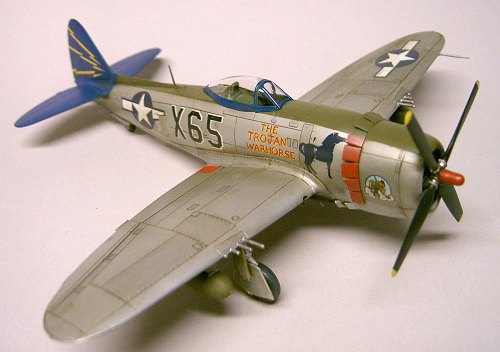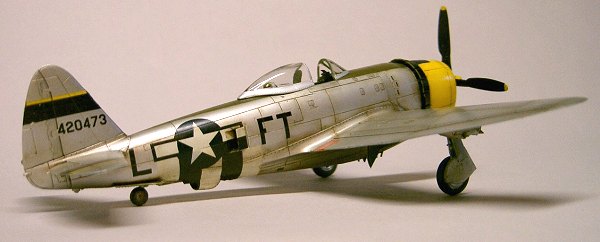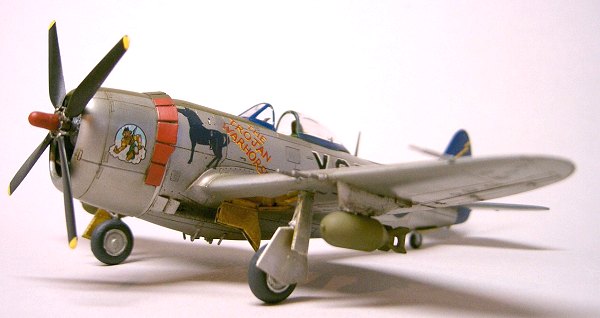
|
KIT: |
Revell AG 1/72 P-47M Thunderbolt |
|
KIT # |
04141 |
|
PRICE: |
$8.50 MSRP |
|
DECALS: |
3 options: 56, 79 & 353 FG |
|
REVIEWER: |
Scott Weir |
|
NOTES: |

|
HISTORY |
Arguably the best fighter/ bomber of WWII, the
Thunderbolt has a combat record that will probably never be surpassed by
any single type. In a time when convention ruled that a fighter should be
small and light weight, Art Kartveli of Republic Aircraft defied that
convention with a two thousand eight hundred cubic inch, eighteen
cylinder, turbo supercharged, five ton, eight gun, armored, aerial
JUGGERNAUT of destruction. Although designed as a high altitude fighter
it was in the ground attack role that the Jug would find itís calling.
 The record speaks volumes.
The record speaks volumes.
1. 423,435 combat sorties with 3,077 losses [less than 1% loss rate]
2. 61,000 vehicles destroyed
3. 8,400 locomotives destroyed
4. 94,000 rail cars destroyed
5. 11,878 aircraft destroyed [about a 50/50 split air and ground kills]
6. 5,000 artillery nests destroyed
7. 688 bridges knocked out
Of the 15,683 P-47ís built, 12,602 of these were the various incarnations of the D series. After the long and successful run of the D, Republic decided to notch it up once more with the M model. Essentially a D-30 with the new Pratt & Whitney R-2800 57C engine and CH-5 turbo-supercharger the P-47 M could generate a maximum 2,800 h.p. [w/water methanol boost] and turn out an astonishing 473 mph at 32,000 ft. as compared to the Dís 426 mph at 30,000 ft. This makes the M the fastest production P-47 model built. In the closing weeks of the war the 56th Fighter Group was able to get the M operational and down several Me262ís much to the unhappy surprise of some Swallow pilots.
|
THE KIT |
For a good description of the kit let me refer you to Michael Campbellís excellent preview.
|
CONSTRUCTION |
 This is pretty much a straight forward kit with few
hang-ups. The belly, spine and wing leading edges require some sanding as
do most kits. There is a little sinkage on top of the wings above the
wheel wells. One can either fill this in or chalk it up to ďcombat metal
stress fatigue.Ē The left wing tends not to want to locate at the
trailing edge. This is easily corrected by using a pair of tweezers as a
spring/clamp between the cockpit and trailing edge of the left wing near
the root while the glue is drying. The best model glue on the planet in
my opinion is automotive lacquer thinner. Not only does it weld styrene
really well but it can also backfill minor joints, many times negating
the need for putty. The best thing about it is itís usually under $10,00
per gallon. I would recommend the medium drying grade for use as a
styrene adhesive.
This is pretty much a straight forward kit with few
hang-ups. The belly, spine and wing leading edges require some sanding as
do most kits. There is a little sinkage on top of the wings above the
wheel wells. One can either fill this in or chalk it up to ďcombat metal
stress fatigue.Ē The left wing tends not to want to locate at the
trailing edge. This is easily corrected by using a pair of tweezers as a
spring/clamp between the cockpit and trailing edge of the left wing near
the root while the glue is drying. The best model glue on the planet in
my opinion is automotive lacquer thinner. Not only does it weld styrene
really well but it can also backfill minor joints, many times negating
the need for putty. The best thing about it is itís usually under $10,00
per gallon. I would recommend the medium drying grade for use as a
styrene adhesive.
If you want to hang the rockets youíll need to drill the holes for the zero length launchers on the inside locaters of the bottom wing before the wing halves are glued together. For the most part this kit fits together really well and construction is quite simple.
|
COLORS & MARKINGS |
One of the many great things about modeling the mighty Jug is the fact thereís about a gazillion schemes one can apply to them. Not to mention some of the brightest, most outrageous paint jobs of the war were applied to P-47ís. The 56th fighter group seemed to be no exception .The first aircraft represented is Capt. B.M. Gladychís P-47M-1 of the 61st Fighter Squadron, 56TH Fighter Group out of Boxted, U.K. This is a straight out of the box build right down to the stock decals, HVARís, and long range tanks. Cockpits and the insides of the cowlings on all three of these aircraft are interior green. First up is to prime the kit in Testors gray primer. Next I painted the rudder red than masked it over.
 After spraying the entire aircraft chrome silver it was
then clear coated in automotive acrylic lacquer cut with PPG DTL16
acrylic lacquer thinner[$20.00 per gl]. This needs to be done with some
caution so the silver enamel base coat doesínt get barbequed. I then
masked off the leading edges of the upper wings and horizontal stabs. The
dark blue was shot over the clear with a home mix of a little black in
some dark blue. To tighten the demarcation line between the upper blue
and cleared silver underside I dip a Q-tip in enamel reducer, ring out
the excess reducer and wipe away any unwanted over spray. Acrylic lacquer
is fairly resilient to conservative applications of enamel thinner. This
also works great for tight upper camo patterns without having to cut and
apply all that mundane, time consuming mask.
After spraying the entire aircraft chrome silver it was
then clear coated in automotive acrylic lacquer cut with PPG DTL16
acrylic lacquer thinner[$20.00 per gl]. This needs to be done with some
caution so the silver enamel base coat doesínt get barbequed. I then
masked off the leading edges of the upper wings and horizontal stabs. The
dark blue was shot over the clear with a home mix of a little black in
some dark blue. To tighten the demarcation line between the upper blue
and cleared silver underside I dip a Q-tip in enamel reducer, ring out
the excess reducer and wipe away any unwanted over spray. Acrylic lacquer
is fairly resilient to conservative applications of enamel thinner. This
also works great for tight upper camo patterns without having to cut and
apply all that mundane, time consuming mask.
After removing the mask on the leading edges and rudder another clear coat was shot for the decal application. The kit decals lay down nicely with some Solvaset. Last on the list is the final coat of clear to seal the decals. Dull coat is applied using the same clear enamel or lacquer and turning the pressure up to about 60 p.s.i. and holding the airbrush about 9 inches away from the model. No more gritty gun clogging dull coat.
EAGLESTONíS EAGLE
The next bird is Glen Eaglestonís P-47D-30, 353rd Fighter Group, 354th Fighter Squadron, 9th Air Force in France during the summer of 1944. Good bare metal finishes in enamel had always been an enigma to me until my best modeling bud who just happens to be my brother in-law hooked me up with Plasti-Kote Aluminum fast drying enamel paint. This is one of my first builds using this and all I can say about is it looks great, lays down beautifully, is cheap and dries faster than a snow cone in Burma.
 To shade the panels I revert back to my childhood. Just
like staying in the lines of a coloring book I lightly fill in the spaces
of the desired panels with a #2 pencil. First coloring front to back then
side to side and finally diagonally in both directions after which I buff
out with a cotton cloth or Q-tip. [Kind of like Metalizer on a stick].
All this takes a mere fraction of the time it would take to mask and
paint all these separate little panels. Remember to use the pencil
lightly as not to score the base coat. Itís best to pencil on a slightly
dulled finish.
To shade the panels I revert back to my childhood. Just
like staying in the lines of a coloring book I lightly fill in the spaces
of the desired panels with a #2 pencil. First coloring front to back then
side to side and finally diagonally in both directions after which I buff
out with a cotton cloth or Q-tip. [Kind of like Metalizer on a stick].
All this takes a mere fraction of the time it would take to mask and
paint all these separate little panels. Remember to use the pencil
lightly as not to score the base coat. Itís best to pencil on a slightly
dulled finish.
Eagleston's markings came from the trusty old Hasegawa kit. For being 20 plus year old decals they laid down wonderfully with a little Solvaset.
Last up raw umber oil paint was applied as a wash and to give it that less than clean, used in the field look. It also tones down the starkness of freshly applied paint.
TROJAN WAR HORSE
 Last in this trilogy is the colorful Trojan Warhorse,
P-47D-27, 79th Fighter Group, 12th Air Force in
Italy during 1944 and 45. The same finish techniques were used on this as
were to Eaglestonís D-30. To make it a D-27 I shaved away the dive flaps
aft of the wheel wells and filled in the landing light on the outboard
port wing with putty. The Hamilton Standard prop and gravity ordinance
are from the Academy kit. The wheels are Hasegawa from the scrap yard.
Decals are from Eagle Strike.
Last in this trilogy is the colorful Trojan Warhorse,
P-47D-27, 79th Fighter Group, 12th Air Force in
Italy during 1944 and 45. The same finish techniques were used on this as
were to Eaglestonís D-30. To make it a D-27 I shaved away the dive flaps
aft of the wheel wells and filled in the landing light on the outboard
port wing with putty. The Hamilton Standard prop and gravity ordinance
are from the Academy kit. The wheels are Hasegawa from the scrap yard.
Decals are from Eagle Strike.
The only mask required was the tail, anti-glare panel and cowling flaps.
|
CONCLUSIONS |
This is without a doubt the finest 1/72nd scale P-47 bubbletop kit on the planet to date. It is nothing short of a tooling masterpiece. The scribing and subtle rivet detail are superb. The overall shape of the airframe, canopy and engine cowling are excellent. It incorporates details never before produced in a Jug of this scale. I can say without any reservation that the Revell of Germany P-47M is about as good a kit as any Hasegawa or Tamiya for which I have had the pleasure of building. It is one of the best bargains I have found in my 30 years of modeling. Since its release in 1999 Iíve continued to shamelessly hoard them from store shelves. Congratulations to Revell AG on an outstanding job for an incredible value.
|
REFERENCES |
Squadron Signal Publications P-47 in Action-------- Larry Davis
P-47 Walk Around ----------Drendel
Thunderbolt/ The P-47 Thunderbolt in the European Theater-------- Ernest R. McDowell
Motorbooks Zemkeís Wolfpack/ The56th Fighter Group in World
War II -------------------------------William N. Hess
Osprey Publications Aircraft of the Aces Series/ P-47 Aces of the Eighth Air Force----Jerry Scutts
The Discovery Wings Channel Airpower Showdown/ Attack Aircraft [In which the Mighty Jug won the honors of Greatest Attack Aircraft Of All Time]
Verlinden Publications For that great raw umber oil paint idea.
If you would like your product reviewed fairly and quickly by a site that has over 250,000 visitors a month, please contact me or see other details in the Note to Contributors.